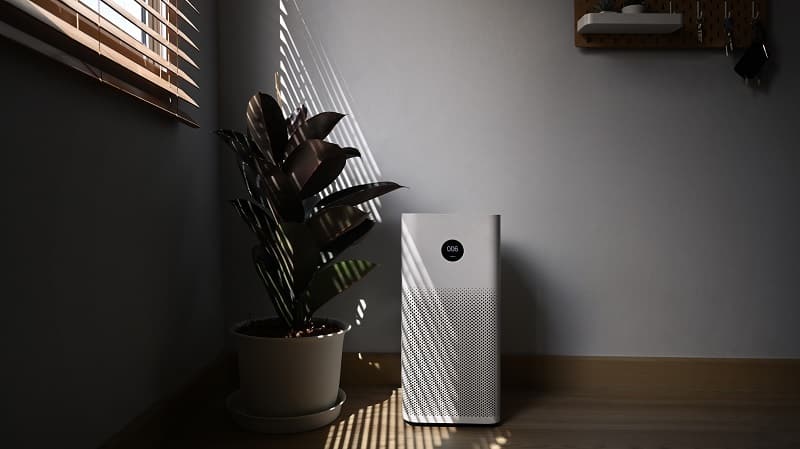Does your air purifier work just fine, but it’s so loud it’s like you’re flying in a jumbo jet?
You’re not alone. As a fellow allergy sufferer, I love my air purifier, but man does that thing make some noise!
To help, I’ve put together a list of easy tips that should help you quiet a noisy air purifier.
If that sounds good, then read on!
Fixing a Loud Air Purifier
Let me tell you something that might put your mind at ease. There’s a very good chance that you will not have to do any repairs on your air purifier, but rather modify the way in which you use it, and make some interface adjustments.
I know how tempting it can be to start thinking about prying your appliance open, and looking for the culprit in there, but please, don’t do that just yet.
We will definitely get there, but only as a last resort. Failing to go about the troubleshooting process in a detailed and orderly way is the quickest path to wasting precious time and money.
Without further ado, here are 6 fixes you can try to make your air purifier a little quieter:
- Lower the fan speed
- Disable auto mode
- Put the appliance behind a piece of furniture
- Remove debris from the filter
- Position the filter properly
- Change the filter
#1 Lower the Fan Speed
There might be nothing wrong with your air purifier
I know this might seem too obvious to consider, but remember that it’s the most seemingly unimportant factor, that we tend to overlook the most.
There might be nothing wrong with your air purifier other than the fact that you’re setting the fan levels too high. If this is the case, it would be very easy to miss, as, during the day, we go about our activities, and the outside world is full of noise, but as soon as night falls, everything becomes quiet.
I know what you might be thinking – but then it’s not going to work as well! Agreed – the purifier will definitely get through less air.
A tip that’s worked well for me is to run the air purifier on high when I’m not in the room. For example in my bedroom, I’ll run the purifier on high with the door closed for around 30 minutes before I go to bed. Then turn it down to low and quiet before getting into bed.
For a living room, try running the purifier on high as you’re going through your day, then setting it to low once you’re kicking back to relax.
#2 Disable Auto Mode
The auto mode might be worse than you think
Ever since auto mode was invented as an air purifier feature, our lives have become much more convenient, and overall better.
Or have they?
I get why you’d want to operate your appliance in auto mode, it’s simple, quick, and requires zero intervention from you; however, this mode might not be the best choice if you want the full “air cleaning” experience at low noise levels.
Let me explain.
While the auto mode is designed to sense the air quality in your home at all times, and activate your appliance when needed, it might be working the machine’s fans too often, and setting them to the max.
Moreover, there have been several studies that have shown that operating your unit in this mode does not guarantee full air cleaning, as it leaves some degree of pollutants in the environment.
Solution: Your electric bills might be a little higher, but, if you really want quieter noise levels and truly clean breathing air in your home, I’d advise against using the auto mode, and setting the appliance to a specific purifying level at all times.
#3 Hide the Machine Somewhere

Placing your appliance behind a sofa or table could reduce the noise
The first time someone suggested I should do this to reduce the noise levels coming from my air purifier, my first thought was, “Of course! It’s so obvious! How come it had never occurred to me?”. The answer is simple. It sounds ridiculous.
But it works like a charm.
If you’ve already made sure that you have set the proper levels of operation, and you don’t use auto mode that often, you might be stuck with an air purifier model that is too loud by design.
If this is the case, your best bet is to place it behind a large object with a padded surface. Soft surfaces are great at absorbing them and preventing them from bouncing around all over the room.
Now, I won’t lie to you, this will compromise your machine’s ability to purify the air to a certain degree, but, if the noise is just too unbearable, this might be a small price to pay for a greater benefit. If the room is properly sealed off from outside air, the purifier will still cycle through all of the room’s air regardless.
Solution: Find the largest piece of furniture you can fit into your room and place your machine behind it. You’ll be amazed at how great this works.
#4 Remove Debris
Clean your filter regularly
Every household appliance requires proper maintenance from time to time, and your air purifier is not the exception.
As time goes by, small particles of pollen, dust, and dirt can collect in your filter, thus compromising its air-sucking abilities. This obstruction can not only make your machine have to work harder to remove all air pollutants, but could also cause overheating, reducing its lifespan dramatically.
If your air purifier was quieter when recently bought it, chances are you have to go inside it and clean the filter, removing any obstructing debris.
Solution: This will vary from model to model, and from manufacturer to manufacturer, but the broad strokes should be similar for all of them.
In order to access, and clean your air purifier’s filter, please follow these steps:
- Unplug your unit, and let it cool down
- Remove the outer plastic panel (it should come off easily)
- Remove the outer filter vent
- Remove the filter
- Carefully vacuum it to remove any debris, and then clean it under running water
- Let it dry completely
- Place it back into the machine, and reassemble
#5 Reposition the Filter

You might have changed your filter incorrectly
When going about the filter cleaning process, you have to be very observant regarding the way in which you reassemble your appliance, as leaving any component lose, could create a lot of noise.
As you know, your air purifier works by sucking in dirty air, and releasing it cleaned after passing it through a filter. It might not seem like it, but the air current it creates can be very strong.
If you’re hearing some rattling noise after reassembling your machine, chances are you did not fit the filter or the outer vent correctly, and they’re moving erratically with the current.
Solution: I know it’s annoying, but you’re going to have to disassemble your appliance again and make sure everything is sitting tightly.
#6 Change the Filter
You should clean your filter frequently
Cleaning your filters might work a couple of times, but eventually, you will have to replace them. There’s just no way around that.
Having clean filters installed at all times is the best way to guarantee your appliance is working properly and actually getting rid of the pollutants you would be breathing otherwise.
If your air purifier is being too loud, and you’ve already cleaned your filters several times, chances are, you need to replace them to get rid of the noise. Sadly, no matter how well you clean them, over time, they’ll become severely obstructed.
It’s the cycle of life of modern-day appliances.
Solution: In order to guarantee optimal operating conditions, you should change your filter every three to six months, or every 30 to 60 days if you suffer from asthma or allergies, and want the cleanest air possible.
Conclusion
Having an air purifier that is too loud can disrupt the peace and quiet that you love and appreciate in your home. It might not be too noticeable during the day, but when night falls, excessive fan noise can cause insomnia and other sleep disorders.
Luckily, as you’ve learned in this piece, addressing most of the issues behind this situation is fairly simple. More often than not, disabling auto mode and cleaning your filters regularly will be enough to get the unit back to its quiet self.
Thank you so much for sticking with me all the way to the end. If you found this article useful, why not keep the learning going through our other incredible resources below? There is no such thing as knowing too much.
Enjoy the silence!







